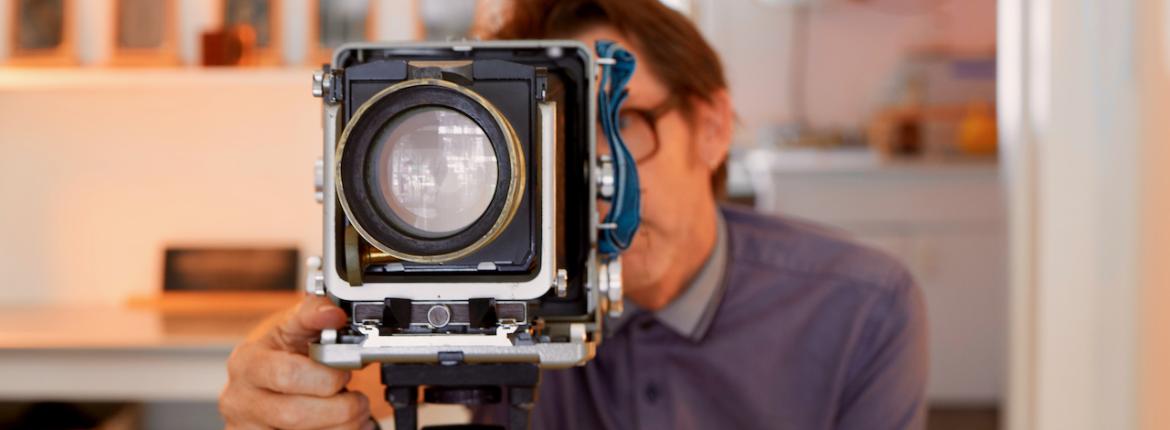Award-winning photographer Adrian Cook knows a thing or two about living the high life: he’s photographed some of the biggest names on the planet, in the world’s most exotic and Insta-worthy locations.

Adrian Cook, wet plate photographer. © Larnie Nicholson
But ask him where his happy place is and it’s not New York, London or Paris. It’s a 1950s Bondwood caravan in the rural Waikato town of Te Aroha. More science lab than mobile home, this is alchemy HQ, and home base for Adrian’s wet plate portrait studio, Tintype Central. A mobile darkroom of the most magical kind, it’s here that Adrian creates dreamy, otherworldly images using techniques from another time.
If you haven’t heard of wet plate collodion, you’re not alone. Invented in 1851 by Frederick Scott Archer, it was the dominant photographic process of the mid-nineteenth century, until gelatin silver bumped it off its perch. Now though, it’s having a renaissance, and here in New Zealand Adrian is leading the charge.
“Digital photography is still my bread and butter, but it’s not what gets me out of bed in the morning,” says Adrian, who has worked with the likes of Kate Moss, Naomi Campbell and U2, and has picked up awards at Cannes and D&AD.
“I started my career back in the 80s when everything was shot on film. Then digital came along which was great, but now I find there are no surprises. Digital has devalued photography because now everyone’s a photographer. If an image isn’t right you can just manipulate it on the computer.”
Looking for a hobby to reignite his passion, Adrian began exploring wet plate eight years ago and quickly became hooked.
“I like being in the dark room and working slowly like you do with film. Instead of shooting 400 images as you would with digital, I shoot just one or two. Plus you get time to talk to the people you’re photographing.”
A portrait session takes about an hour, but much of that includes setting up the shot – when you’re only taking one frame it’s important to get the composition right. Adrian uses the exact same process photographers did 150 years ago, right down to his original 1850s camera lenses. After coating the tin or glass plate with collodion, he immerses it in silver nitrate for three minutes and it becomes light sensitive. From there it’s a high speed dash to the camera to put the plate in the film holder, shoot the image and get back to the darkroom to develop, rinse, fix, wash, dry and varnish it. Time is of the essence.

Adrian Cook at work in his photography studio. © Larnie Nicholson
“It’s called wet plate for a reason – the whole process has to be done while it’s wet, so you’ve got 10 or 15 minutes, less on a hot day. That’s why you need a mobile darkroom.”
Adrian estimates that globally there are around 10,000 wet plate photographers, but he knows of less than a dozen in Aotearoa New Zealand. “Of those, I’m probably the most commercial and I think I’m the only one with a portrait studio. I run workshops teaching people how to do it, but not many go on to pursue it because it’s harder than you’d think – plus you’ve got to source the chemicals and set up the darkroom. It’s actually a lot of work!” But the stunning results make it well worth the effort.
“The problem with photos today is that no one ever gets anything printed, it’s all on your phone. But with tin type, it’s a one-off artwork that lasts for generations, like a painting. It’s about having something real in your hand, not on a screen.”
Since shifting back to New Zealand from Australia last year, the wet plate side of Adrian’s work has been gaining traction. “When I first got back I did 50 portraits for the Auckland Writers Festival and it’s grown from there.”
Now he divides his time between Auckland and Te Aroha and regularly hits the road – old Bondwood in tow – to conduct wet plate portrait sessions at some of the country’s most-loved institutions, from the Sarjeant Gallery and Te Ahu Museum to Howick Historical Village, Pah Homestead and Pioneer Village Kaikohe.
“I do lots of portraits for special occasions like Mother’s Day, 21st birthdays, Valentine’s Day and even staff Christmas parties. There’s a big resurgence in handmade stuff – people are over throwaway and want something that lasts longer than six months. With wet plate it’s like an heirloom. You know it’s going to be around for the next generation.”
Read more from this AA Directions issue while you're here:
- Discover a talented builder of replica 1931 Alfa Romeo racing cars
- We meet a healer using traditional rongoā (Māori medicine)
- A family-owned business making high-quality knives for hunters and chefs
- Did you know that the AA offers Small Business Insurance?
Reported by Vanessa Trethewey for our Autumn 2023 issue




